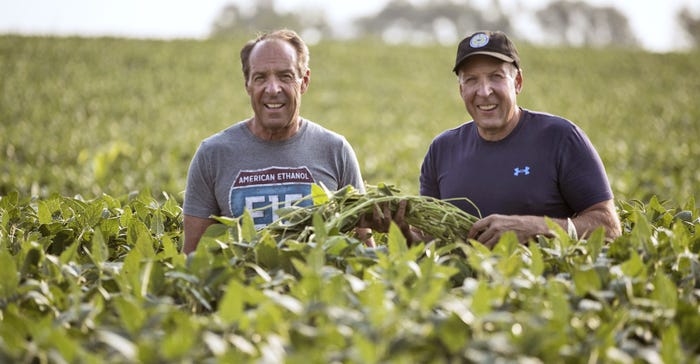April 29, 2019

MORE BUSHELS: Craig, left, and Gene Stehly check their soybean crops. USDA NRCS South Dakota, Joe Dickie
By Lura Roti
Do you worry that trying new conservation and soil health practices will cut your already thin profit margins?
Consider Gene and Craig Stehly’s experience.
“Our first motivation is always profit. We are running a business,” says Gene, who, along with his brother, Craig, has adopted many conservation practices.
Over their 40-year career, the Stehly brothers have converted to 100% no-till, planted cover crops and set aside land for wildlife. They recently were honored with the Legacy Award by the South Dakota Soil Health Coalition.
“If you look at the result of the journey we started 40 years ago, we have soil that is much healthier in every way,” Gene says.
Their soil organic matter has risen from about 2% to 4.5% or more.
“Now, we can raise more bushels with fewer inputs,” Gene says.
No profit then, either
Profits were scarce when the Stehlys, of Mitchell, S.D., began farming in the early 1980s. A depressed farm economy, coupled with multiple seasons of drought and soil test results showing low organic matter, motivated them to begin no-tilling.
“In those drought years, no-till worked well to stop erosion and conserve moisture,” Craig says.
It also reduced equipment costs, time and labor.
In today’s higher moisture climate, no-till, together with other soil health-building practices, helps manage water efficiently.
“It comes down to managing the water you have as efficiently as you can,” Craig says. “Where we farm, we have most of our moisture in the spring. Instead of letting it run off, soils with higher organic matter and cover crop residue, hold water in the soil for when the plants need it.”
System approach
“Soil health isn’t just one thing,” Craig explains. “It’s a system approach combining no-till, crop rotation, cover crops and planting native grass seed into our sensitive areas — wetlands and salinity areas along watersheds — to try to make our land not only profitable but sustainable for the future.”
Grid sampling was also key. Since 1979, the brothers have closely monitored their soil’s organic matter and available nutrients.
Working closely with the Natural Resources Conservation Service and the South Dakota Department of Game, Fish and Parks, they took less-productive cropland acres out of production and returned them to native grass or wetlands.
“We have been developing habitat since the 1980s. It goes back to making every acre count,” Gene says. “In this Prairie Pothole Region, on average, 10% of every field we farm has some reason we cannot make money on it. Most of the time it is wetlands, which is why we utilize wetland CRP so much.”
“Instead of getting a negative return, there are areas in nearly every one of our fields that we have converted back to wetlands or native prairie,” Craig says.
The Stehlys manage 45 parcels of land enrolled in various conservation programs, including a bee program establishing pollinator blocks in fields that are close to bee hives. Their actions not only enhance soil health but also improve water infiltration, reduce runoff, and create wildlife and pollinator habitats.
A 350-acre riparian area along Firesteel Creek that feeds into Lake Mitchell is one of their favorite success stories. Ten years ago, it was a pasture with a creek running through it. Today, the area is home to more than 48 native forbs, pollinator insects, deer, pheasants, meadowlarks, and other wildlife and birds. A 2018 test showed dramatic improvement in water quality in the creek.
Telling their story
The Stehlys make a point to share their soil health story with their landlords and others in the community. They show the benefits of their management practices during annual hunting events in wildlife habitat they developed.
“It’s really important to dispel myths associated with farming and let consumers know that as farmers we care about the soil and water because they are essential to our livelihood,” Gene says. “We need to share that we are taking voluntary steps to improve water quality through our practices.”
More information
For more information about conservation and soil health practices that could improve your farm and your bottom line, visit your local NRCS office or see the South Dakota Soil Health Coalition website, www.sdsoilhealthcoalition.org.
Roti is a writer with the South Dakota Soil Health Coalition.
You May Also Like




